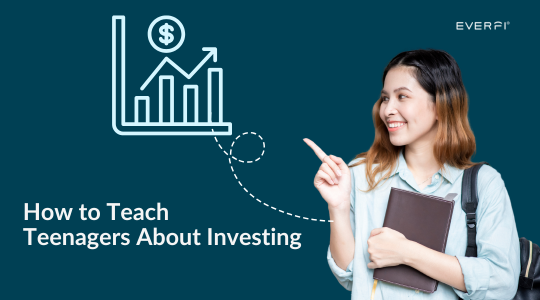What if a few lessons could give your students a better future?
Few school districts have embraced investing for teens. Nonetheless, providing solid investment advice is one of the best ways to enrich someone’s life. The earlier teens learn these lessons, the sooner they will be on the path to creating a better life for themselves and their loved ones.
Are you a teacher or administrator wondering how to incorporate investing as a teenager into your curriculum? This guide covers everything you need to know, including free resources that can help transform your students’ lives for the better!
Main Takeaways
- Investing can be very rewarding, and students should learn this skills as soon as possible.
- Because investing is a complex topic, students will need the help of their teachers in the form of interactive games and lessons.
- By teaching the right investment concepts early on, teachers can lay a foundation for the student’s financial literacy and financial freedom.
Table of Contents
- Key Investment Concepts to Introduce
- Options to Simulate Investing
- Real Application Opportunities for Teens
- 9 Tips for Teachers
- EVERFI’s Free Investing Course for High School Students
Key Investment Concepts to Introduce
Sometimes, teachers have trouble creating lessons about investing as a teenager because they don’t know where to start. Just what are the most important concepts to introduce as a foundation for future lessons? And what makes those concepts so vital for anyone who wants to learn how to start investing as a minor?
Below, you’ll find a brief list of concepts and why they are so important to introduce in the classroom. Once you incorporate these ideas into your lessons, both you and your students will be one step closer to a lifetime of making comfortable investments, thanks to increased financial literacy.
Stock Market Basics
Students learning how to invest as a teen must first learn the basics. This includes how to invest through a broker, how to understand the Nasdaq, the S&P 500, and the New York Stock Exchange. All of this provides the fundamentals necessary for a student to understand the stock market before they ever make their first investment. Teachers should approach this topic through the lens of pure potential: No matter what your financial situation is, understanding the market is a way of eventually obtaining a more comfortable lifestyle.
Investing vs. Trading
Those interested in investing as a teenager must learn the difference between investing vs. trading. In short, investors buy stock anticipating long-term benefits, whereas traders try to buy at low prices and sell at high prices as a way of generating a quick profit. Teachers should ultimately present this information neutrally, allowing students to choose whether they want to be an investor, trader, or both.
401(k)s, Roth IRAs, and Retirement Investing
When students learn how to start investing as a minor, they will be in a better position to prepare for their golden years. Accordingly, they need to learn about 401(k)s, Roth IRAs, and other methods of retirement investing. Teachers should cover these concepts as different ways of covering retirement costs and how the best retirement investment strategies may change over time.
Options to Simulate Investing
Actually, investing as a teenager can be difficult for many reasons. Fortunately, teachers can simulate investment options in the classroom, giving students important hands-on experience. Below, you’ll find a few free websites to help your own school district simulate investment activities for students:
These online options provide all the fun and learning opportunities of the stock market without any of the risk. That makes them a great way to learn how various investment concepts work before trying winning strategies out in the real world.

For a more comprehensive experience, Marketplaces: Investing Basics is a great option to equip students with an understanding of how the market works and the confidence to participate in it.
Real Application Opportunities for Teens
Once students learn how to invest as a teen, they may have trouble getting started because you usually must be 18 to set up investment accounts. Fortunately, there are a few other easy ways for students to get around this restriction and begin their investment journey.
- Parents can open custodial accounts with their teens; when the teen turns 18, they will have full control of the account.
- Parents can also play stock games with their children and offer practical investment advice.
- Some brokers offer fractional shares, which allow teens to invest in major companies without spending large amounts of money on stocks.
Investing as a teenager is difficult but not impossible. Getting started early is a great way for students to thrive financially later in life.
9 Tips for Teachers
For young people, learning how to start investing as a teenager can be pretty intimidating, thanks to all the complex concepts. But with the right teacher, even the most complicated concepts can be easy to understand.
If you’re a teacher helping students learn how to invest as a teen, there are a few easy ways to simplify lessons. Below, you’ll find our top tips for teachers to help you get started!
1. Investment Group Project
Some students will inevitably have an easier time understanding investing than others. By creating investment group projects, you can pair the strongest learners with the weakest ones. This helps bring everyone up to speed, and requiring presentations can help the entire class learn from each group’s successes and failures.
2. Bring in an Expert
Sometimes, students have trouble understanding investing because everything seems so abstract. One way to get around this is by bringing in a young, local investor to answer student questions. Seeing someone who is a successful investor can make everything seem more tangible, and this expert may very well be able to answer stock market questions better than the teacher, thanks to their extensive financial education.
3. Use Board Games
Younger students may be able to learn much about investing by playing the classic board game Monopoly. On a very basic level, the game teaches students how investing wisely early on helps make it easier to acquire what you want later on. The game also emphasizes the concept that good investment is one of the most reliable ways to grow your wealth.
4. Focus on Budgeting
Many students will likely need to learn more about budgeting before they understand the stock market. Because of this, you should create lessons about budgeting that lead directly into lessons about investing (incidentally, EVERFI’s foundational financial literacy course, EVERFI: Financial Literacy for High School covers budgeting). Not only will this provide the fundamental information students need to succeed, but it will also help them learn never to invest money they cannot afford to lose.
5. Competitive Fantasy Portfolio
Believe it or not, the vast majority of teenagers are interested in investing. In fact, 91% of teens who are not currently making investments want to get started, and a whopping 75% of teens plan to make their first investment before entering college. In order to accommodate student interest and prepare them to become successful investors, teachers should allow their students to participate in a fantasy portfolio. Such portfolios use actual stock market methods and investment techniques, allowing those who play them to become successful investors when they try their hand at the real thing. Plus, teens often respond positively to the competitive aspect of this, allowing teachers to get greater participation and buy-in from their students.
6. Show Plenty of Good (and Bad) Investment Examples
One of the reasons that many students are hesitant to embrace the stock market is that they don’t really understand it or think it’s all that useful. In fact, one recent study found that only 50% of teens think the stock market is a good thing, and that 37% of teens would avoid investing even if they were given money to do so. This confusion and negativity stem from the fact that teens are likely very familiar with horror stories about investments gone wrong, be they from the 2008 housing crash to America’s recent focus on tariffs. To counteract such narratives, teachers should consider providing plenty of examples of both good and bad investments. By knowing more about which investments to avoid and which to embrace, more students will feel comfortable exploring the stock market for themselves.
7. Show TikTok Videos (No, Really!)
Teachers are often divided about TikTok and its ability to distract students who already have trouble focusing on the task in front of them. However, TikTok can be a powerful teaching tool simply because of how popular it is with students. A recent survey discovered that 58% of teens use TikTok each day, making the platform a significant part of their entertainment ecosystem. Teachers can lean into teen reliance on this platform by showing students TikTok investment videos created by successful investors. This technique is effective because the use of TikTok will help engage students who would otherwise tune out of the discussion altogether. Plus, students who like what they see will be able to look up the user’s other videos, further increasing their interest in and understanding of the stock market.
8. Shark Tank: Stock Market Edition
The reality show Shark Tank is popular for a reason: the promise that all it takes is a good enough idea for contestants to become rich. The show is surprisingly popular with teenagers for this reason, in large part because many of them have major ambitions of their own. A recent survey of 500 adult entrepreneurs discovered that 13% of them went into business for themselves when they were 18 or younger. Because of these facts, teachers should consider conducting a Shark Tank-style game that is based on the stock market. Basically, each student must pick a stock they are passionate about and pitch it to the rest of the class with the goal of making them interested in investing in it. Overall, this exercise encourages students to research the stocks they are most interested in while helping them understand the different ways those stocks might be marketed directly to them. Additionally, here are some Shark Tank lesson plan ideas for students in middle school grades.
9. Lessons in Compound Interest
At the end of the day, a teen’s understanding of the stock market will only be as robust as their understanding of mathematics. Unfortunately, their collective understanding is worse than ever: post-pandemic surveys have revealed that math test scores for eighth graders had dropped by 27 points. This means that students coming into high school are not well-equipped to understand more advanced mathematics concepts, including compound interest. Therefore, teachers should offer lessons focused solely on compound interest. Once students understand how this concept works, they will be able to better focus on conquering the stock market.
EVERFI’s Free Investing Course for High School Students
Investing for teens is a complex subject, but you don’t have to teach it by yourself. That’s what Miami-based high school teacher Yolette Mezadieu learned, testifying that “teaching students about generational wealth and financial literacy is essential. I have used EVERFI’s resources for years. Having students learn about investment through Marketplaces in a non-intimidating, fun, and practical manner allowed them to embrace the concept.”
With the right educational resources, you can streamline lessons about investment and the stock market while preparing your students for a successful life after high school. To get started, be sure to check out EVERFI’s free, standards-aligned high school course on Critical Investment Education for High School Students!
—————————–

Chris Snellgrove is a college writing professor with over 15 years of experience as a teacher, professor, and instructor. He’s primarily taught at the high school and college levels, but has also led ESL programs for primary school students. In addition to his teaching experience, he has extensive experience with SEO, small business optimization, and ghostwriting for hundreds of clients in all different fields.

